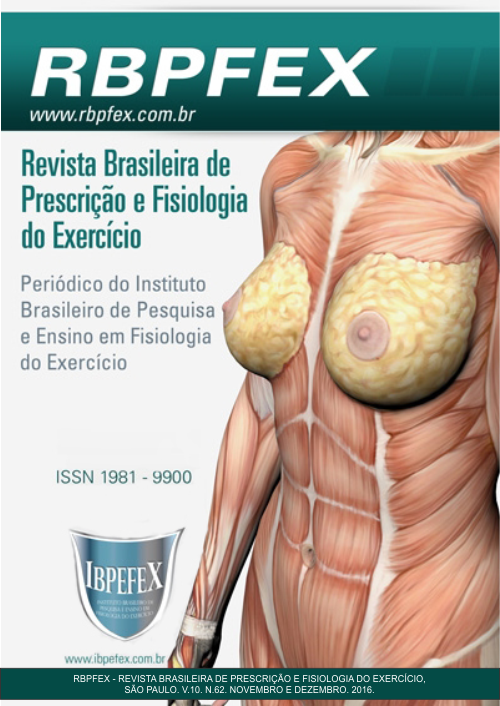nfluence of different types of breathing in cardiac response during resistance exercise
Abstract
Purpose: To analyze the cardiovascular response, using as parameter the heart rate (HR), systolic blood pressure (SBP) and double-product (DP) in three different types of breathing, defined in active breathing (AB), passive breathing (PB) and Valsalva maneuver (VM). Methods: 15 volunteers were recruited, aged 18 and 26, all healthy and with minimum experience of 6 months with strength exercises. The exercise protocol consisted of three sets of 12 repetitions maximum in leg press machine 45. The Wilcoxon test was used to compare the hemodynamic variable at the end of each series and between breath types. Results: There was significant difference in SBP, HR and DP between the time Pre (rest) and all subsequent series in all types of breathing. The MV showed higher SBP, HR and DP compared to other types of breathing in all three series of the year. Conclusion: MV entails greater cardiac overload when compared to other types of breathing.
References
-Berent, R.; Von Duvillard, S.P.; Crouse, S.F.; Sinzinger, H.; Green J.S.; Schmid P. Resistance training dose response in combined endurance-resistance training in patients with cardiovascular disease: a randomized trial. Archives of Physical Medicine and Rehabilitation. Vol. 92. Num. 10. 2011. p. 1527-1533.
-Farinatti, P.T.; Assis, B.F. Estudo da freqüência cardíaca, pressão arterial e duplo-produto em exercícios contra-resistênciae aeróbio contínuo. Revista Brasileira de Atividade Física e Saúde. Vol. 5. Num. 2. 2012. p. 5-16.
-Finnoff, J.T.; Smith, J.; Low, P.A.; Dahm, D.L.; Harrington, S.P. Acute hemodynamic effects of abdominal exercise with and without breath holding. Archives of Physical Medicine and Rehabilitation. Vol. 84. Num. 7. 2003. p. 1017-1022.
-Hackett, D.A.; Chow C.M. The Valsalva Maneuver: Its Effect on Intra-abdominal Pressure and Safety Issues During Resistance Exercise. The Journal of Strength & Conditioning Research. Vol. 27. Num. 8. 2013. p. 2338-2345.
-Haykowsky, M. J.; Eves N. D.; Warburton, R.D.E.; Findlay, M.J. Resistance exercise, the Valsalva maneuver, and cerebrovascular transmural pressure. Medicine and Science in Sports and Exercise. Vol. 35. Num. 1. 2003: p. 65-68.
-Leite, T.C.; Farinatti, P.T.V. Estudo da freqüência cardíaca, pressão arterial e duplo-produto em exercícios resistidos diversos para grupamentos musculares semelhantes. Revista Brasileira de Fisiologia do Exercício. Vol. 2. Num. 1. 2003. p. 29-49.
-Malfatti, C.A.; Rodrigues, S.Y.; Takahashi, A.C.M.; Silva, E.; Menegon, F.A.; Mattielo-Rosa, S.M.; Catai, A.M. Análise da resposta da freqüência cardíaca durante a realização de exercício isocinético excêntrico de grupamento extensor de joelho. Revista Brasileira de Fisioterapia. Vol. 10. Num. 1. 2006. p. 51-57.
-McArdle, W.D.; Katch, F.I.; Katch, V.L. Exercise Physiology: Nutrition, Energy, and Human Performance, Lippincott Williams & Wilkins. 2010.
-Niewiadomski, W.; Pilis, W.; Laskowska D.; Gasiorowska, A.; Cybulski, G.; Strasz, A. Effects of a brief Valsalva manoeuvre on hemodynamic response to strength exercises. Clinical Physiology and Function Imaging. Vol. 32. Num. 2. 2012. p. 145-157.
-O'Connor, P.; Sforzo, G.A.; Frye, P. Effect of breathing instruction on blood pressure responses during isometric exercise. Physical Therapy. Vol. 69. Num. 9. 1989. p. 757-761.
-Ogoh, S.; Ainslie, P.N. Regulatory mechanisms of cerebral blood flow during exercise: new concepts. Exercise and Sports Science Reviews. Vol. 37. Num. 3. 2009. p. 123-129.
-Polito, M.D.; Farinatti P.T.V. Considerações sobre a medida da pressão arterial em exercícios contra-resistência. Revista Brasileira de Medicina do Esporte. Vol. 9: 2003. p. 25-33.
-Powers, S.K.; Howley, E.T. Fisiologia do exercício: teoria e aplicação ao condicionamento e ao desempenho, São Paulo. Manole. 2011.
-Williams, M.A.; Haskell, W.L.; Ades, P.A.; Amsterdam, E.A.; Bittner, V.; Franklin, B.A.; Gulanick, M.; Laing, S.T.; Stewart, K.J.; American Heart Association Council on Clinical Cardiology; American Heart Association Council on Nutrition, Physical Activity, and Metabolism. Resistance exercise in individuals with and without cardiovascular disease: 2007 update a scientific statement from the american heart association council on clinical cardiology and council on nutrition, physical activity, and metabolism." Circulation Vol. 116. Num. 5. 2007. p. 572-584.
-Zanetti, H.R.; Ferreira, A.L.; Haddad, E.G.; Gonçalves, A.; Jesus, L.F.; Lopes, L.T.P. Análise das respostas cardiovasculares agudas ao exercício resistido em diferentes intervalos de recuperação." Revista Brasileira de Medicina do Esporte. Vol. 19. 2013. p. 168-170.
-Zatsiorsky, V. M.; W. J. Kraemer. Science and Practice of Strength Training, Human Kinetics. 2006.
-Zebrowska, A.; Gasior, Z.; Jastrzebski, D. Cardiovascular effects of the valsalvamaneuver during static arm exercise in elite power lifting athletes. Advances in Experimental Medicineand Biology. Vol. 755. 2013. p. 335-342.
Authors who publish in this journal agree to the following terms:
- Authors retain the copyright and grant the journal the right of first publication, with work simultaneously licensed under the Creative Commons Attribution License BY-NC which allows the sharing of the work with acknowledgment of the authorship of the work and initial publication in this journal.
- Authors are authorized to enter into additional contracts separately for non-exclusive distribution of the version of the work published in this journal (eg, publishing in institutional repository or book chapter), with acknowledgment of authorship and initial publication in this journal.
- Authors are allowed and encouraged to post and distribute their work online (eg, in institutional repositories or on their personal page) at any point before or during the editorial process, as this can bring about productive change as well as increase impact and impact. citation of published work (See The Effect of Free Access).






